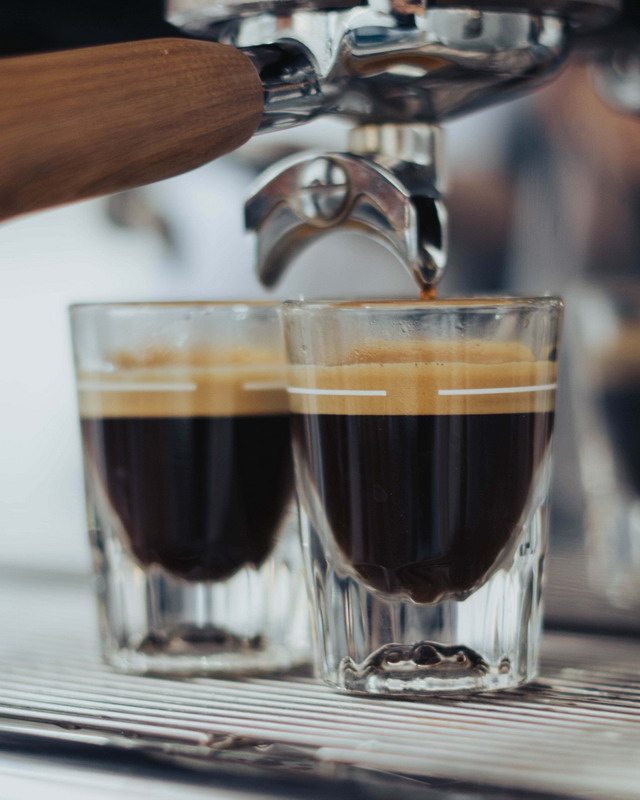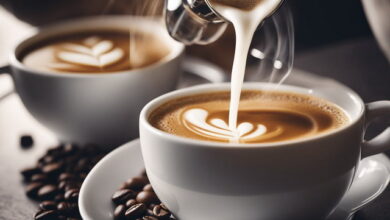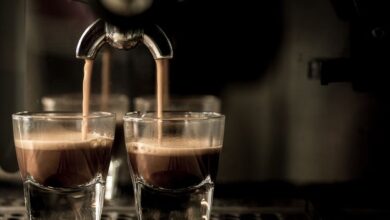Caffeine in Double Shot Espresso: How Much is Too Much?
Caffeine in Double Shot Espresso
Double shot espresso is a popular coffee beverage that is enjoyed by millions of people worldwide. It is a concentrated form of coffee that is made by pushing hot water through finely ground coffee beans. The result is a small, but potent, cup of coffee that is known for its strong flavor and high caffeine content.
Understanding the basics of espresso is important to understand the caffeine content of double shot espresso. Espresso is made by forcing hot water through finely ground coffee beans under high pressure. The pressure helps to extract more flavor and caffeine from the coffee beans, resulting in a stronger and more concentrated cup of coffee. Double shot espresso is made by using twice the amount of coffee grounds and water as a single shot, resulting in a higher caffeine content.
Key Takeaways
- Double shot espresso is a concentrated form of coffee made by pushing hot water through finely ground coffee beans.
- Espresso is made by forcing hot water through finely ground coffee beans under high pressure, resulting in a stronger and more concentrated cup of coffee.
- Double shot espresso contains more caffeine than a single shot, making it a popular choice for those looking for a strong caffeine boost.
Understanding Espresso
History and Definition
Espresso is a concentrated coffee beverage that originated in Italy in the early 20th century. It is made by forcing pressurized hot water through finely ground coffee beans. The result is a small, strong shot of coffee with a layer of crema on top.
The term “espresso” comes from the Italian word “esprimere,” which means “to express.” This refers to the way the coffee is quickly extracted from the beans under pressure. Espresso is typically served in small cups, known as demitasse cups, and is often enjoyed as a standalone drink or as the base for other coffee beverages.
Espresso Brewing Techniques
There are several techniques for brewing espresso, but the most common method involves using an espresso machine. The machine uses pressure to force hot water through a compacted puck of finely ground coffee. The pressure helps to extract more flavor and caffeine from the beans, resulting in a stronger and more concentrated shot of coffee.
Another popular brewing technique is the stovetop espresso maker, also known as a Moka pot. This method involves placing water in the bottom chamber of the pot, adding coffee to a filter basket, and placing the basket on top of the water. As the water boils, it is forced up through the coffee and into the top chamber of the pot.
Whether brewed with an espresso machine or a stovetop pot, the result is a strong and flavorful shot of coffee that is enjoyed by coffee lovers around the world.
Caffeine Basics
What Is Caffeine?
Caffeine is a naturally occurring stimulant that belongs to a class of compounds known as xanthines. It is found in a variety of plants, including coffee beans, tea leaves, and cocoa beans. Caffeine is also added to many soft drinks, energy drinks, and medications.
Caffeine has a number of effects on the body, including increased alertness, improved mood, and enhanced physical performance. It is also a mild diuretic, which means that it can increase urine production.
Caffeine Mechanism of Action
Caffeine works by blocking the action of a neurotransmitter called adenosine. Adenosine is a naturally occurring chemical that builds up in the brain over the course of the day, promoting feelings of tiredness and drowsiness. By blocking adenosine, caffeine promotes wakefulness and alertness.
Caffeine also stimulates the release of other neurotransmitters, such as dopamine and norepinephrine, which can improve mood and increase mental and physical performance.
The effects of caffeine can vary depending on a number of factors, including the dose, the individual’s sensitivity to caffeine, and the form in which it is consumed. For example, coffee and tea contain other compounds that can interact with caffeine and affect its absorption and metabolism.
Overall, caffeine is a widely used and well-studied compound that has a number of effects on the body and brain.
Caffeine Content Analysis
Measuring Caffeine in Espresso
Measuring the exact amount of caffeine in a double shot espresso can be challenging due to various factors that can affect caffeine levels. However, on average, a double shot espresso contains between 120 and 150 milligrams of caffeine 12. It is essential to note that caffeine levels can vary depending on the type of beans used, the roast level, and the brewing method.
Several methods can be used to measure caffeine levels in espresso. One of the most common methods is high-performance liquid chromatography (HPLC), which involves separating the various components of the espresso and measuring the caffeine content 13. Another method is infrared spectroscopy, which measures the absorption of infrared light by caffeine molecules 3.
Factors Affecting Caffeine Levels
Several factors can affect the caffeine levels in a double shot espresso. One of the most significant factors is the type of beans used. Robusta beans typically have higher caffeine levels than Arabica beans 1. The roast level can also affect caffeine levels, with lighter roasts having higher caffeine levels than darker roasts 2.
Another factor that can affect caffeine levels is the brewing method. Espresso machines that use higher water pressure and hotter water tend to extract more caffeine from the beans 12. The size of the grind can also affect caffeine levels, with finer grinds extracting more caffeine than coarser grinds 3.
In conclusion, a double shot espresso typically contains between 120 and 150 milligrams of caffeine. However, caffeine levels can vary depending on several factors, including the type of beans used, the roast level, and the brewing method. Measuring caffeine levels in espresso can be challenging, but several methods can be used to obtain accurate results. Understanding the factors that can affect caffeine levels can help coffee lovers make informed decisions about their caffeine intake.
Comparative Caffeine Studies
Espresso vs Regular Coffee
When it comes to caffeine content, espresso is often considered to be stronger than regular coffee. However, this is not always the case. In fact, the caffeine content of a double shot of espresso (around 120-150 mg) is roughly equivalent to that of a regular cup of coffee (around 95 mg).
One study found that there was no significant difference in the caffeine content of espresso and regular coffee when comparing similar serving sizes. However, it is worth noting that the serving size of espresso is much smaller than that of regular coffee, so the concentration of caffeine is higher in espresso.
Espresso vs Drip Coffee
Drip coffee is another popular type of coffee that is often compared to espresso. Drip coffee is typically brewed using a filter, which allows for a slower extraction process. This can result in a lower concentration of caffeine compared to espresso.
One study found that the caffeine content of a 16-ounce drip coffee ranged from 145-175 mg, while the caffeine content of a double shot of espresso ranged from 47-75 mg. However, it is important to note that the serving size of drip coffee is much larger than that of espresso, so the total amount of caffeine consumed may be higher.
Overall, the caffeine content of espresso can vary depending on a number of factors, including the type of beans used, the brewing method, and the serving size. While espresso is often considered to be stronger than regular coffee or drip coffee, this is not always the case. It is important to consider the serving size and concentration of caffeine when comparing different types of coffee.
Health and Wellness Insights
Caffeine’s Health Benefits
Caffeine, the primary active ingredient in double shot espresso, is known for its ability to boost energy and mental alertness. Studies have also shown that caffeine can improve physical performance, aid in weight loss, and reduce the risk of certain diseases such as Parkinson’s, Alzheimer’s, and liver cancer. Moreover, caffeine has been found to enhance mood and improve cognitive function in some individuals.
Potential Risks and Side Effects
While caffeine can have positive effects on health, it is important to note that excessive consumption can lead to negative side effects such as jitters, anxiety, and increased heart rate. The amount of caffeine in a double shot espresso is higher than that found in a regular cup of coffee, and consuming too much caffeine can lead to insomnia, digestive issues, and even addiction. Additionally, caffeine can interact with certain medications and supplements, so it is important to consult a healthcare professional before increasing caffeine intake.
Overall, while caffeine in double shot espresso can provide a quick energy boost and potential health benefits, it is important to consume it in moderation and be aware of the potential risks and side effects.
Caffeine for Energy and Performance
Caffeine is a natural stimulant found in many beverages, including coffee. It is widely used for its ability to boost energy levels and enhance workout performance. A double shot espresso is a popular choice for those looking for a quick caffeine boost.
Boosting Energy Levels
Caffeine works by blocking the action of adenosine, a neurotransmitter that promotes sleep and suppresses arousal. By inhibiting adenosine, caffeine increases the activity of other neurotransmitters, such as dopamine and norepinephrine, which promote wakefulness and arousal.
A double shot espresso contains approximately 120-150 milligrams of caffeine, which is enough to provide a quick energy boost. However, it is important to note that the effects of caffeine can vary depending on individual factors, such as age, weight, and tolerance.
Enhancing Workout Performance
Caffeine has been shown to enhance workout performance by increasing endurance, reducing fatigue, and improving focus. It does this by increasing the production of adrenaline, a hormone that prepares the body for physical activity.
A double shot espresso can be a useful tool for athletes looking to improve their performance. However, it is important to note that caffeine can also have side effects, such as jitteriness, anxiety, and insomnia. It is recommended that athletes experiment with caffeine intake during training to determine the optimal dosage for their individual needs.
In conclusion, a double shot espresso can be an effective way to boost energy levels and enhance workout performance. However, it is important to use caffeine in moderation and be aware of its potential side effects.
Nutritional Profile of Espresso
Calories and Macronutrients
Espresso is a low-calorie beverage, with a typical double shot containing only about 10 calories. This is due to the fact that espresso is made by forcing hot water through finely ground coffee beans, resulting in a small serving size that is concentrated in flavor and caffeine.
In terms of macronutrients, espresso does not contain any significant amounts of protein, fat, or carbohydrates. However, it is important to note that many people choose to add milk, sugar, or other flavorings to their espresso drinks, which can significantly increase the calorie and macronutrient content.
Vitamins and Minerals
While espresso does not contain any significant amounts of vitamins or minerals, it does provide a small amount of potassium, magnesium, and niacin. These nutrients are naturally present in coffee beans and are extracted during the brewing process.
It is worth noting that the amount of nutrients in espresso can vary depending on the type of coffee beans used, the brewing method, and other factors. However, in general, espresso is not a significant source of vitamins and minerals and should not be relied upon as a primary source of nutrition.
Weight Management and Caffeine
Caffeine is a popular ingredient in many weight loss supplements due to its ability to stimulate metabolism and enhance fat oxidation. While caffeine’s role in weight management is still being studied, it is believed to have a thermogenic effect, which means it can increase the body’s energy expenditure and help burn more calories.
Caffeine’s Role in Metabolism
Caffeine is a stimulant that can help increase metabolic rate, which is the rate at which the body burns calories. According to a study published in the American Journal of Clinical Nutrition, caffeine consumption can increase metabolic rate by 3-11%, with higher doses having a greater effect. This increase in metabolic rate can lead to an increase in calorie burn and may help with weight loss.
Espresso and Appetite Suppression
Espresso, especially double shot espresso, can help suppress appetite and reduce food intake. A study published in the journal Appetite found that consuming caffeine before a meal can reduce calorie intake by up to 9%. This is believed to be due to caffeine’s ability to stimulate the central nervous system and reduce feelings of hunger.
However, it is important to note that while caffeine can have a positive impact on weight management, it should not be relied upon as the sole method of weight loss. A healthy diet and regular exercise are still the most effective ways to achieve and maintain a healthy weight.
Overall, caffeine in double shot espresso can play a role in weight management by increasing metabolic rate and suppressing appetite. However, it is important to consume caffeine in moderation and as part of a healthy lifestyle.
Consumer Guide to Double Shot Espresso
Selecting Quality Coffee Beans
When it comes to making a great double shot espresso, selecting quality coffee beans is crucial. Look for beans that are freshly roasted and have a rich, dark color. The roast date should be within the last two weeks to ensure maximum freshness and flavor.
It’s also important to consider the origin of the beans. Different regions produce different flavor profiles, so experiment with beans from different countries to find your preferred taste. Some popular coffee bean origins include Brazil, Colombia, Ethiopia, and Guatemala.
Espresso Machines and Tools
To make a perfect double shot espresso, you need the right equipment. A high-quality espresso machine is essential, as it will allow you to control the temperature and pressure during the brewing process. Look for machines with a built-in grinder, as freshly ground beans are key to a great espresso.
In addition to a good espresso machine, you’ll need a few other tools. A tamper is necessary to evenly compress the coffee grounds, and a milk frother will allow you to add milk to your espresso drinks. A scale is also useful for measuring the correct amount of coffee and water.
Overall, making a great double shot espresso requires attention to detail and the right equipment. By selecting quality coffee beans and investing in a good espresso machine and tools, you can enjoy delicious espresso drinks from the comfort of your own home.
Preparing the Perfect Double Shot
When it comes to preparing the perfect double shot espresso, there are a few key steps to follow. These include grinding and tamping the coffee, as well as using the right extraction techniques.
Grinding and Tamping
To start, it’s important to use freshly roasted coffee beans and grind them to a fine consistency. This will help to ensure that the coffee is extracted evenly and that the flavor is consistent. Once the coffee is ground, it should be tamped firmly and evenly into the portafilter basket. This will help to ensure that the water passes through the coffee evenly and that the shot is extracted properly.
Extraction Techniques
When it comes to extracting the double shot, there are a few different techniques that can be used. One common technique is to use a slow and steady extraction, which can help to bring out the full flavor of the coffee. Another technique is to use a shorter, more intense extraction, which can help to create a stronger, more concentrated shot.
Ultimately, the key to preparing the perfect double shot espresso is to experiment with different techniques and find the one that works best for your taste preferences. By following these basic steps and practicing your technique, you can create a delicious and satisfying double shot every time.
Espresso in Culinary Culture
Influence on Modern Cuisine
Espresso has become a staple in modern cuisine, particularly in Italian cuisine. Its strong flavor and aroma make it a popular ingredient in various desserts, such as tiramisu and affogato. It is also used in savory dishes like espresso-rubbed steak and espresso-braised short ribs. Espresso’s versatility in the kitchen has made it a popular ingredient for chefs around the world.
Beyond its use in cooking, espresso has also influenced the culinary industry in other ways. The rise of specialty coffee shops has led to the popularity of latte art, a technique where baristas create intricate designs on the surface of espresso-based drinks. Latte art has become an important part of coffee culture, with competitions held around the world to showcase the skills of baristas.
Espresso-Based Beverages
Espresso-based beverages have become a staple in coffee shops around the world. The most popular of these is the cappuccino, which consists of equal parts espresso, steamed milk, and milk foam. Another popular beverage is the latte, which has more steamed milk and less foam than a cappuccino. Espresso shots are also commonly used as a base for other coffee drinks, such as Americanos and macchiatos.
It is important to note that the caffeine content of espresso-based beverages varies depending on the size of the drink and the number of shots of espresso used. A double shot of espresso typically contains around 58-185 milligrams of caffeine, while a single shot has around 29-100 milligrams of caffeine [1]. Understanding the caffeine content of espresso-based beverages is important for those who are trying to limit their caffeine intake.
Overall, espresso has become an important part of culinary culture, both in cooking and in coffee shops around the world. Its strong flavor and aroma have made it a popular ingredient in various dishes, while its versatility has made it a staple in the coffee industry.
[1] Source: https://www.chefsresource.com/how-much-caffeine-in-double-shot/Frequently Asked Questions
How does the caffeine content compare between a double shot espresso and a regular cup of coffee?
A double shot of espresso contains about 120 milligrams of caffeine on average, which is generally higher than the caffeine content of a regular cup of brewed coffee. However, the total amount of caffeine consumed depends on the size and strength of the cup of espresso as well.
What is the typical amount of caffeine found in a double shot espresso at Starbucks?
According to Chef’s Resource, a double shot of espresso at Starbucks typically contains about 150 milligrams of caffeine. However, the actual amount of caffeine can vary based on factors such as the type of coffee beans used and the brewing method.
Can consuming two shots of espresso significantly increase caffeine intake?
Yes, consuming two shots of espresso can significantly increase caffeine intake. A double shot of espresso contains about 120 milligrams of caffeine on average, which is equivalent to the amount of caffeine found in a regular cup of brewed coffee. Therefore, consuming two shots of espresso is equivalent to consuming two cups of coffee in terms of caffeine content.
What are the health implications of having 200 mg of caffeine in a double espresso?
According to Mayo Clinic, consuming up to 400 milligrams of caffeine per day is generally considered safe for most healthy adults. However, consuming more than this amount can lead to side effects such as insomnia, nervousness, restlessness, rapid heartbeat, and muscle tremors.
How does the caffeine concentration in a double shot espresso relate to the maximum daily recommended caffeine intake?
A double shot of espresso contains about 120 milligrams of caffeine on average, which is equivalent to about one-third of the maximum daily recommended caffeine intake for healthy adults. Therefore, consuming one or two double shots of espresso per day is generally considered safe for most healthy adults.
Is the caffeine effect of a double espresso stronger than that of a single shot of regular espresso?
Yes, the caffeine effect of a double shot of espresso is generally stronger than that of a single shot of regular espresso. A double shot contains twice the amount of coffee and caffeine as a single shot, which means it has a more concentrated and potent effect on the body.








